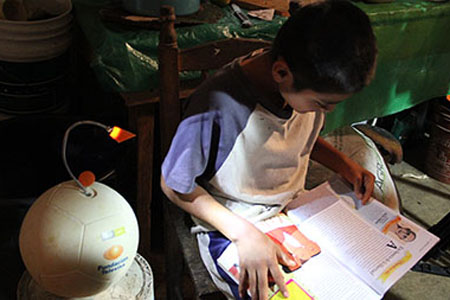Soccer's 'Electric' Potential

(ISNS) – In June, as national soccer teams from around the world resume playing qualification games for the 2014 World Cup, a group of 20-somethings will kick off a soccer-related project with a global purpose that goes beyond athletic competition.
They will start full-scale manufacture of soccer-style balls that generate and store electric power when kicked around.
After playtime with these "Soccket" balls, families and communities that lack reliable access to electricity can use the balls' power for lighting and – eventually – other electrical applications.
Surveys suggest that more than 1.3 billion people worldwide live without a consistent source of electricity.
That lifestyle can cost money. "Some Mexican families spend up to a quarter of their income on candles and other light sources during months-long power outages," said Victor Angel, product manager of Uncharted Play, Inc., the company that developed the Soccket.
It looks like an ordinary soccer ball on the outside, but the Soccket actually contains a small direct current generator and a storage unit.
"As the ball rolls, the mechanism spins a generator to produce electricity that goes through our custom port and is stored in a lithium ion battery like those in laptops," Angel explained.
Sign up for the Live Science daily newsletter now
Get the world’s most fascinating discoveries delivered straight to your inbox.
After a kick around, a small flap in the ball's skin allows entry of a cord that feeds the stored power from the battery into a lamp. Typically, a half hour of play with the ball can provide three hours worth of light.
"This is not intended to solve the world's energy crisis," Angel said. "But it conveys the idea that play is good and sustainability is not necessarily about making sacrifices. You can have fun while creating a benefit for the environment."
The idea of an energy-harnessing ball originated in 2008 in a student project by Jessica Matthews and Julia Silverman, social science students at Harvard University who lacked any experience in engineering.
Three years later, the pair founded New York City-based Uncharted Play, described as "a for-profit social enterprise dedicated to improving lives through play," and recruited Angel, an engineering graduate of Boston University. Since then the company has worked on perfecting the ball for play and mass production.
"The proof-of-concept design was a long way from a ball that you could play with," Angel recalled. After an upgraded version prepared by a design firm proved too heavy and broke too easily, the team took the project in-house.
"We knew who was going to be using it," Angel continued. "We were all very young and perhaps naïve enough to think we could do it."
To provide the feel of a genuine soccer ball, the team had to compensate for the weight of the Soccket's electronics. That meant finding a low-density, extremely durable material for the ball's external shell. The material had to be tough enough to protect the ball's electronics but soft enough to be headed safely.
"Controlling all those variables was very difficult," Angel recalled. "We came up with a dual-density foam that was rigid on the exterior and elastic on the interior."
The result was a ball weighing less than 17.5 ounces; a little heavier than a regulation soccer ball, which weighs 15.9 ounces.
Soccer professionals have welcomed the Soccket. "It's surprising, unprecedented, and generous," said Vicente del Bosque, coach of Spain's national team, the current World Cup champion.
Engineering experts also approve. "The simplicity of using the product is perhaps the best part of the experience for those who may not be used to using high-tech products," said Simon Martin, co-founder of EvD Media in Portland, Oregon.
To test the evolving design, the team sent advanced prototype balls to communities in Mexico, Chicago, and New Jersey. "These units are very close to what the final product will be," Angel said. The company is still working on issues related to care and maintenance, including repairs.
At the same time the company is hastening toward full-scale production, scheduled to start in the middle of this month.
Uncharted Play will manufacture what it calls portable power kits. Each will contain a Soccket ball and 10 portable lamps that can run for an hour each after plugging into the ball for 25 seconds each. This could allow a team to share the benefits of a single ball.
In pilot programs so far, Uncharted Play usually relies on non-governmental organizations and corporate sponsors to distribute its balls. They are not currently available in stores.
A former science editor of Newsweek, Peter Gwynne is a freelance science writer based in Sandwich, Massachusetts.
Inside Science News Service is supported by the American Institute of Physics.









